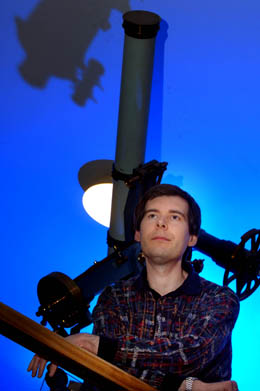The truth is out there
Scientists undertaking a new ‘opinion survey’ of unknown planets say that the sky is filled with planets that we are not yet aware of.
The latest study, co-led by astronomers at the University of St Andrews, suggests that we are only aware of a ‘tiny’ fraction of planets out there.
In the study published by Nature today (Wednesday 11 January 2012), researchers found that there are at least half as many planets as there are stars in the sky. However, the authors suggest that, even though we can’t see them, ‘wherever we look in the sky, there are planets’.

Dr Martin Dominik.
The underlying observations and analysis were carried out by an international team co-led by Dr Martin Dominik, a Royal Society University Research Fellow at the University of St Andrews, who describes the study as ‘an opinion survey’ of the skies.
Dr Dominik commented, “In the last 15 years, we have seen the count of known planets beyond the Solar system rising from none to about 700. We also know that so far we have detected only a tiny fraction of planets out there. We expect hundreds of billions exist in the Milky Way alone.”
The new findings collated six years’ worth of data collected by researchers monitoring Milky Way stars that undergo a transient brightening known as a ‘gravitational microlensing event’. They complement data obtained with NASA’s ‘Kepler’ mission, which detects planets from dips in the light of stars they transit. While Kepler is sensitive only to planets that are closer to their parent star than the Earth is to the Sun, gravitational microlensing covers the full separation range from Venus to Saturn.
Interestingly, massive gas-giant planets like Jupiter did not feature prominently in the findings despite their larger detectability. With the discovery of the small distant icy world OGLE-2005-BLG-390Lb in 2006, this demonstrates that less massive planets are the more common. Despite the fact that only a small number of planets have been detected, the researchers can estimate their abundance from the sample obtained.
“It is like an opinion survey”, Dr Dominik explained. “Rather than taking a complete count, we look at a representative sample.”
Using a network of telescopes distributed over the southern hemisphere, from Tasmania and Western Australia to South Africa and Chile, the team of researchers were able to observe the skies around the clock.
Dr Dominik continued, “Probably ever since mankind existed, we have shared our fascination about the myriads of pinpoints of light in the night sky – making us wonder whether they hint at other worlds like ours or rather unlike ours. The first count of other planets did not start until 1995 with the first detection of a planet orbiting a star other than the Sun, and we could subsequently start pointing telescopes to other stars known to host planets. But now we understand that there is more out there.
“We do not know yet where all the planets are, how big or small, dense or fluffy they are, or whether they are home to life or not, but our latest results tell us that while we may not see all the planets, wherever in the sky we look, they are there.”
The work is now being followed up by the MiNDSTEp (Microlensing Network for the Detection of Small Terrestrial ExoPlanets) campaign, which pushes the search for new worlds into hitherto uncharted territory down to the mass of the Moon.
ENDS
Notes to Editors
Dr Martin Dominik is available for interview on 01334 654898 or 07777 64 25 64, or email [email protected]
The team used a network of 1m-class telescopes dubbed PLANET (Probing Lensing Anomalies NETwork).
More than half of the total data was acquired with the Danish 1.54m telescope at ESO La Silla, which is now a core facility of the MiNDSTEp (Microlensing Network for the Detection of Small Terrestrial Exoplanets) campaign.
OGLE-2005-BLG-390Lb was the most Earth-like and probably least massive planet at the time of the announcement of its discovery in January 2006, provided the first observational hint for Earth-like planets being common in the Universe, and is still listed as probably most distant planet known in “Guinness World Records” (2012 edition).
Note to Picture Editors
Images are available from the Press Office – contacts below.
Issued by the Press Office
Contact Gayle Cook on 01334 467227, 07900 050 103, email [email protected]
Ref:Truth out there 110112
View the latest University news online at www.st-andrews.ac.uk/news
Follow us on twitter: http://twitter.com/univofstandrews
Category Research